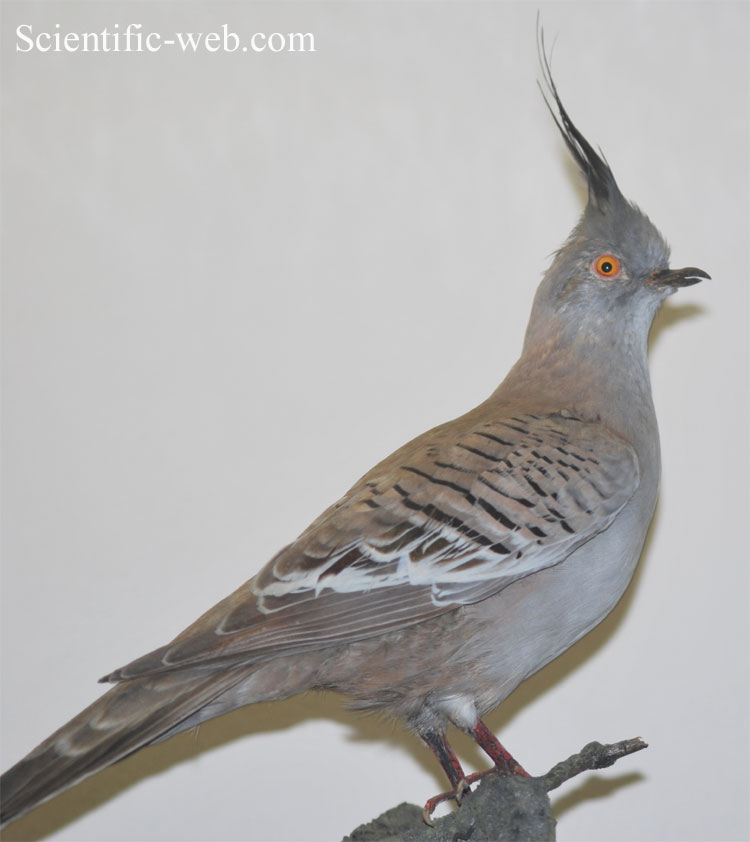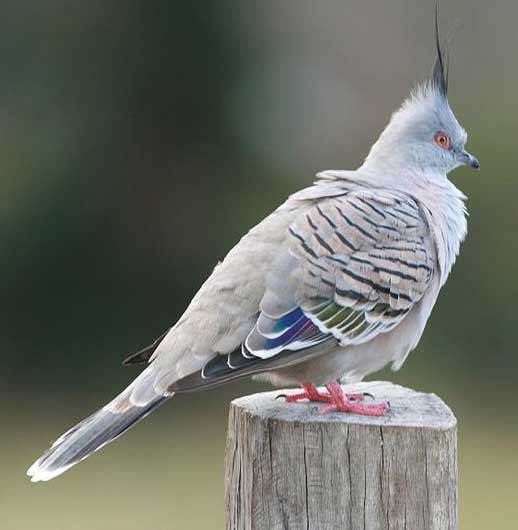Ocyphaps lophotes , Photo: Michael Lahanas Cladus: Eukaryota Name Ocyphaps lophotes (Temminck, 1822) Synonyms * Geophaps lophotes Reference Nouveau recueil de planches coloriées d'oiseaux livr.24 pl.142 Vernacular names
Ocyphaps lophotes (*) The Crested Pigeon (Ocyphaps lophotes) is a bird found widely throughout mainland Australia except for far tropical north areas. It is the only member of the genus Ocyphaps.There are only two Australian pigeon species that possess an erect crest, being the Crested Pigeon and the Spinifex Pigeon. The Crested Pigeon is the larger of the two species.
The call is a "whoop"! voiced repeatedly but singly when alarmed. Distribution and habitat Habitat is grasslands, brush and wooded areas but they can also be seen at watercourses, homestead gardens, pastoral areas, sports grounds, and golf courses. Their habitat has expanded since settlement has produced pastoral lands (previously they were only found in inland and Western Australia). Foraging for grain, has adapted to grain farming areas, often feeding on the noxious weed of Salvation Jane. They are commonly known as the topknot pigeon. Behaviour Their most distinctive behaviour is the beating and whistling sound their wings make when they take off. This is most likely to draw the attention of predators to birds on the wing, and away from any birds remaining on the ground and as an alarm call to other pigeons [1]. When the birds land, the tail tilts upwards and the flight patterns are similar to the those of the Spotted Turtle-Dove. They are generally sedentary. Although can be seen in pairs but they can be highly social and tend to be seen in packs. They are highly gregarious birds when in contact with humans. Breeding While they breed throughout the year, it is more common in the warmer months. Males approach females and begin an elaborate mating dance; they bob their bodies up and down, while opening and closing their wings like a fan with each bob. This is accompanied by a soft hooting which is timed with the bobbing. If the female is interested, she will remain generally stationary as the male approaches, until copulation is attempted. Nesting usually occurs in shrubs or trees. Nests usually consist of a platform of twigs. They lay two oval, white and glossy eggs. The eggs usually hatch 3 weeks after they were laid. Both parents incubate the eggs. References 1. ^ Gill, Victoria (2 September 2009). "Pigeons' wings sound the alarm". BBC News. http://news.bbc.co.uk/1/hi/sci/tech/8232570.stm. Retrieved 2009-09-02. * BirdLife International (2004). Ocyphaps lophotes. 2006. IUCN Red List of Threatened Species. IUCN 2006. www.iucnredlist.org. Retrieved on 12 May 2006. Database entry includes justification for why this species is of least concern Source: Wikipedia, Wikispecies: All text is available under the terms of the GNU Free Documentation License |
|


